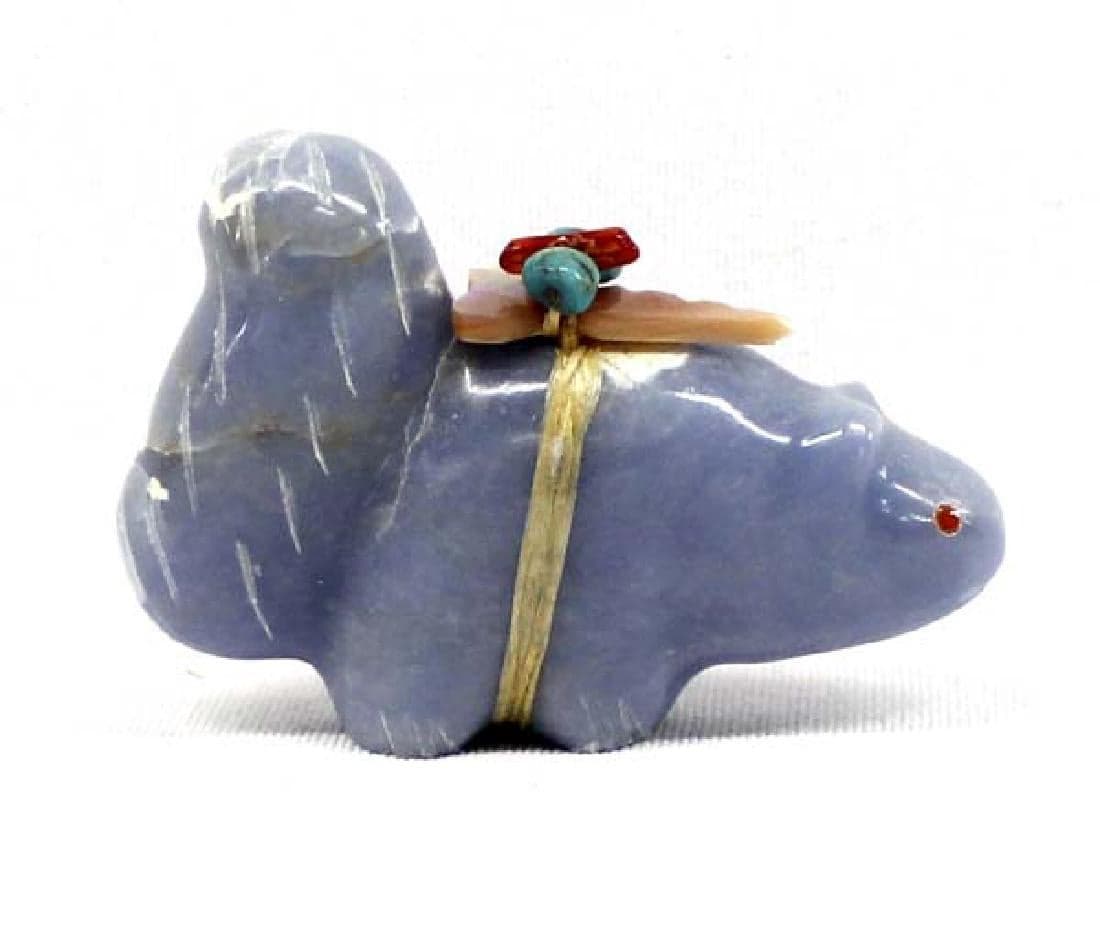Anhydrite (Angelite) Value, Price, and Jewelry Information
Rare and difficult to cut, anhydrite is seldom faceted. However, this material can be carved into beautiful objects. “Angelite,” a blue-gray variety, has become a popular choice for lapidary arts.
3 Minute Read
Rare and difficult to cut, anhydrite is seldom faceted. However, this material can be carved into beautiful objects. “Angelite,” a blue-gray variety, has become a popular choice for lapidary arts.
Start an IGS Membership today
for full access to our price guide (updated monthly).Anhydrite (Angelite) Value
Comments
Anhydrite doesn't occur in abundance. When exposed to water over time, it alters into the much more commonly found gypsum. Not surprisingly, facetable material is rarer still. Furthermore, with excellent cleavage planes in three directions, anhydrites prove challenging to cut and fragile for wear. With a hardness range of 3-3.5, they're very susceptible to scratching, which further limits their use as jewelry stones.
Nevertheless, historically, artisans have carved objects and cut cabochons from this material.
Anhydrites usually have pale, soft colors. Blues, violets, and pinks are especially prized.
Angelite
This translucent, blue-gray anhydrite variety known by the trade name "angelite" or "angeline" has become a popular gem material. Discovered in Peru, it was introduced to worldwide gem markets in the late 1980s. This material has been used for beads, spheres, and carvings. Of course, these trade names carry deliberate angelic connotations. The gem's color may evoke sky blue or, perhaps, a "heavenly" blue.
Vulpinite
This white-gray, marble-like textured material from Volpino, Italy is used locally for cabs and as a decorative stone.
Bowel Stone
Anhydrite that occurs in folded, concretionary forms is known as bowel stone. This variety name also carries deliberate connotations.
Blue "Egyptian" Anhydrite
The Ancient Egyptians used white anhydrite as well as a distinctive blue-tinted variety to create beautiful objects. However, the ancient source of the blue material, which takes a good polish, has never been found.
Identifying Characteristics
Cleavage
Because of the intersection of anhydrite's cleavage planes at right angles, these gems may break apart and reveal cube-like (pseudo-cubic) forms. This appearance has led to another name for this gemstone: "cube spar." Despite appearances, anhydrites have an orthorhombic crystal habit, not a cubic or isometric habit.
Distinguishing Anhydrite from Marble
While marble will effervesce when exposed to hydrochloric acid, anhydrite will not. An acid test may help distinguish carved or crystal anhydrites from marble items that may appear similar. However, keep in mind that acid testing is a destructive technique. Conduct this examination only as a last resort on an inconspicuous part of the object.
Synthetics
Anhydrite has many practical applications. Like its more abundant "alter ego," gypsum, it's used in a variety of construction materials as well as fertilizers. However, it exceeds gypsum in both calcium content and solubility, so it makes a better soil treatment. Thus, there's an industrial demand to synthesize this material but no known jewelry use for it.
Enhancements
Blue and violet colors in anhydrites disappear when heat treated. However, gamma ray bombardment will restore them. Therefore, these colors possibly occur naturally due to natural radiation in the earth. Please note, natural specimens aren't radioactive or harmful.
Sources
Notable sources of gem-quality material include the following:
- Simplon Tunnel, Switzerland: pale purple cleavages, facetable.
- Canada: Nova Scotia; Faraday Mine, Bancroft, Ontario (large purplish masses, some facetable).
- Peru: in addition to angelite, other colors.
- Italy: in addition to vulpinite, other varieties.
- Iran: facetable.
- Mexico: large blue masses, very lovely color, as well as other colors.
- United States: New Jersey; New Mexico; South Dakota; Texas.
- Austria; France; Germany; India; Poland; Sri Lanka.
Stone Sizes
Rarely faceted anhydrites usually come in small sizes (1-5 carats). However, faceters have cut gems up to 9 carats, so the potential exists for larger sizes. Cleavage masses could provide larger rough.
Swiss and Canadian localities produce most of the faceted material, usually in purplish or pale pink colors.
- Private Collection: 2.86 (pink-blue bicolor, Bancroft).
Care
Due to their cleavage and relatively low hardness, anhydrites must be cut and handled with great care. For jewelry, avoid ring use and use protective settings if possible. Consider creating earrings, pendants, and bracelets, instead. Of course, carvings and decorative objects will hopefully face fewer risks.
Keep any anhydrites dry, especially if placed in storage. They will readily absorb moisture and, over time, turn wholly or partly into gypsum.
Don't wipe dust off anhydrites. Since household dust consists mostly of silicon quartz, which is far harder (7) than anhydrites, you'll scratch them. Pat them with a lint-free cloth, instead.
For more recommendations, consult our gemstone jewelry care guide.
Joel E. Arem, Ph.D., FGA
Dr. Joel E. Arem has more than 60 years of experience in the world of gems and minerals. After obtaining his Ph.D. in Mineralogy from Harvard University, he has published numerous books that are still among the most widely used references and guidebooks on crystals, gems and minerals in the world.
Co-founder and President of numerous organizations, Dr. Arem has enjoyed a lifelong career in mineralogy and gemology. He has been a Smithsonian scientist and Curator, a consultant to many well-known companies and institutions, and a prolific author and speaker. Although his main activities have been as a gem cutter and dealer, his focus has always been education.
International Gem Society
Related Articles
What is Gemstone Cleavage?
Shattuckite Value, Price, and Jewelry Information
Feldspar Value, Price, and Jewelry Information
Thaumasite Value, Price, and Jewelry Information
Never Stop Learning
When you join the IGS community, you get trusted diamond & gemstone information when you need it.
Get Gemology Insights
Get started with the International Gem Society’s free guide to gemstone identification. Join our weekly newsletter & get a free copy of the Gem ID Checklist!
